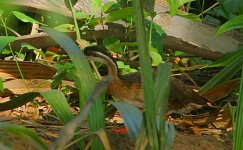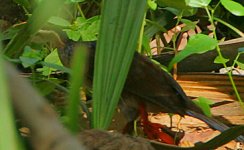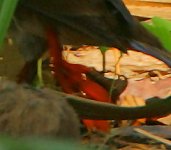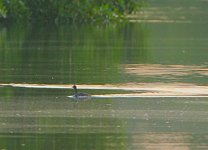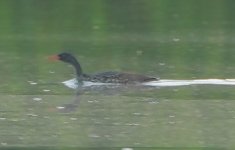Steve G
RAINBIRDER
One of West Africa's most sought-after birds The African Finfoot is a furtive, shy & elusive bird of well-vegetated rivers & dense mangroves.
We were very fortunate in managing to see three separate birds during our recent trip to The Gambia. One was seen in flight & initially appeared to be a shabby dull dark-brown juvenile Long-tailed Cormorant until it came close enough to see the huge bright orange feet & bright red bill. A second bird was watched briefly but closely from our stationary boat in the River Gambia National Park (Baboon Island). It fed on insects in the surface film of the river at high tide (the river Gambia is huge & though this section is freshwater high tide at the river mouth pushes back up the river raising the water level in the freshwater section)-easiest time to see Finfoot -before scurrying up the bank & into dense cover. It was only when the bird started to head for cover that my wits returned enough to snatch a couple of images!
Our third bird was the most amazing -an adult male watched well for about 7-8 minutes from the verandah of our floating lodge at Makasutu. It was even a bedroom tick though my wife was not sure what all the fuss was about! Again I nearly missed the opportunity of an image & the bird had moved on somewhat by the time I got my gear together for a picture.
AFRICAN FINFOOT (Podica senegalensis)
Finfoot belong to the family Heliornithidae which contains an asian species -the Masked Finfoot & the central/south american Sungrebe. The family has uncertain affinities resembling grebes in appearance but is probably related to the rails.
Very little is known about the behaviour of these birds which favour the aquatic fringes of riverine forest, woodland streams & dense mangrove forest. Finfoot swim with a neck-pumping motion when relaxed but if disturbed swim fast & direct to the nearest cover with the slightly kinked neck almost flat on the water. They also climb & clambour well despite their large orange finned-feet.
Apparently these birds nest in tangled roots or creepers low over the water producing only 2-3 young which seem to be cared for mainly ( ?exclusively) by the female. Finfoot are rarely vocal but adult males have been reported to produce a loud roaring boom though this remains to be substantiated.
The breeding male has rather dark upperparts body plumage with pale spangling & slightly paler underparts. The foreneck/hindneck are often contrastingly bicoloured with a thin grey line running from the eye down the side of the neck. The daggerlike bill is bright red, the stiff tail long & dark whilst the legs & feet are bright orange-red.
The female is an altogether paler bird with a red-brown beak, darker hindneck whitish on the lores, chin, throat & foreneck. There is a brown area extending down the neck from behind the eye thickly edged white and the female thus seems to have a more prominent neck/facial pattern. Immatures resemble females but are much duller in the face/neck.
The enclosed images are pretty poor but at least give a reasonable impression of the appearance & furtive nature of this bird.
The first two images are of a female taken at the River Gambia National Park. The third image shows the large lobed toes which gives the bird its common name.
The remaining two images are of a male seen at Makasutu lodges at dawn.
We were very fortunate in managing to see three separate birds during our recent trip to The Gambia. One was seen in flight & initially appeared to be a shabby dull dark-brown juvenile Long-tailed Cormorant until it came close enough to see the huge bright orange feet & bright red bill. A second bird was watched briefly but closely from our stationary boat in the River Gambia National Park (Baboon Island). It fed on insects in the surface film of the river at high tide (the river Gambia is huge & though this section is freshwater high tide at the river mouth pushes back up the river raising the water level in the freshwater section)-easiest time to see Finfoot -before scurrying up the bank & into dense cover. It was only when the bird started to head for cover that my wits returned enough to snatch a couple of images!
Our third bird was the most amazing -an adult male watched well for about 7-8 minutes from the verandah of our floating lodge at Makasutu. It was even a bedroom tick though my wife was not sure what all the fuss was about! Again I nearly missed the opportunity of an image & the bird had moved on somewhat by the time I got my gear together for a picture.
AFRICAN FINFOOT (Podica senegalensis)
Finfoot belong to the family Heliornithidae which contains an asian species -the Masked Finfoot & the central/south american Sungrebe. The family has uncertain affinities resembling grebes in appearance but is probably related to the rails.
Very little is known about the behaviour of these birds which favour the aquatic fringes of riverine forest, woodland streams & dense mangrove forest. Finfoot swim with a neck-pumping motion when relaxed but if disturbed swim fast & direct to the nearest cover with the slightly kinked neck almost flat on the water. They also climb & clambour well despite their large orange finned-feet.
Apparently these birds nest in tangled roots or creepers low over the water producing only 2-3 young which seem to be cared for mainly ( ?exclusively) by the female. Finfoot are rarely vocal but adult males have been reported to produce a loud roaring boom though this remains to be substantiated.
The breeding male has rather dark upperparts body plumage with pale spangling & slightly paler underparts. The foreneck/hindneck are often contrastingly bicoloured with a thin grey line running from the eye down the side of the neck. The daggerlike bill is bright red, the stiff tail long & dark whilst the legs & feet are bright orange-red.
The female is an altogether paler bird with a red-brown beak, darker hindneck whitish on the lores, chin, throat & foreneck. There is a brown area extending down the neck from behind the eye thickly edged white and the female thus seems to have a more prominent neck/facial pattern. Immatures resemble females but are much duller in the face/neck.
The enclosed images are pretty poor but at least give a reasonable impression of the appearance & furtive nature of this bird.
The first two images are of a female taken at the River Gambia National Park. The third image shows the large lobed toes which gives the bird its common name.
The remaining two images are of a male seen at Makasutu lodges at dawn.




